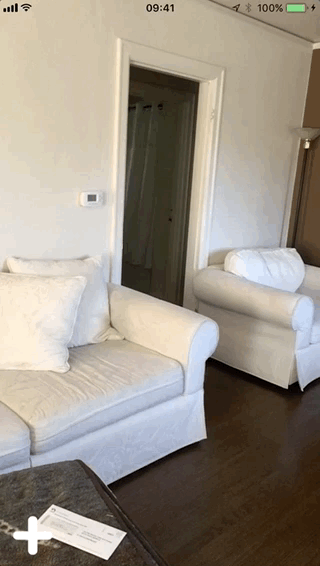CubesInSpace
This demo allows the user to place cubes in space by tapping on screen. The cubes are physical bodies and respond to being 'hit' with the phone
This project borrows from a number of different repositories:
Thanks to ARBrush for SCNVector 3 extensions and inital AR Setup. See that HERE
Thanks to FloorIsLava for plane detection and configuration. See that HERE
Thanks to RayWenderlich for some SceneKit Pointers. Check them out HERE
Creating a box that follows the phone position
This function should be thrown in with all of your other initialization code in 'viewDidLoad()'
func setupPhoneNode() {
let shape = SCNPhysicsShape(geometry: SCNBox(width: 0.0485, height: 0.1, length: 0.0049, chamferRadius: 0), options: nil)
let cubeBody = SCNPhysicsBody(type: .kinematic , shape: shape)
cubeBody.restitution = 0
let cubeGeometry = SCNBox(width: 0.04, height: 0.1, length: 0.01, chamferRadius: 0)
let boxMaterial = SCNMaterial()
boxMaterial.diffuse.contents = UIColor.clear
boxMaterial.locksAmbientWithDiffuse = true;
cubeGeometry.materials = [boxMaterial]
phoneNode = SCNNode(geometry: cubeGeometry)
//Move in front of screen
phoneNode.position = getPositionRelativeToCameraView(distance: 1).position
phoneNode.physicsBody = cubeBody
sceneView.scene.rootNode.addChildNode(phoneNode)
}First you need to get the position and orientation of your device. Here's a function to do just that.
func getPositionRelativeToCameraView(distance: Float) -> (position: SCNVector3, rotation: SCNVector4) {
var x = Float()
var y = Float()
var z = Float()
let cameraLocation = self.sceneView.pointOfView!.position
let rotation = self.sceneView.pointOfView!.rotation
let direction = calculateCameraDirection(cameraNode: rotation)
x = cameraLocation.x + distance * direction.x
y = cameraLocation.y + distance * direction.y
z = cameraLocation.z + distance * direction.z
let position = SCNVector3Make(x, y, z)
return (position, rotation)
}
For usability reasons, I traced a vector normal from the phones screen by about 10 cm.
Apply this code to your phone node during your regular update cycle. In my case: 'func renderer(_ renderer: SCNSceneRenderer, willRenderScene scene: SCNScene, atTime time: TimeInterval'
func updatePhoneNode() {
//Move in front of screen
let phonePositioningInfo = getPositionRelativeToCameraView(distance: 0.1)
phoneNode.position = phonePositioningInfo.position
phoneNode.rotation = phonePositioningInfo.rotation
}Create blocks in 3-D Space:
func spawnShape(point: SCNVector3, size: CGFloat) {
let currentTime = CFAbsoluteTimeGetCurrent()
if currentTime - lastSpawn > 0.1 {
//Initialize cube shape and appearance
let cubeGeometry = SCNBox(width: size, height: size, length: size, chamferRadius: 0)
let boxMaterial = SCNMaterial()
boxMaterial.diffuse.contents = UIImage(named: "crate")
boxMaterial.locksAmbientWithDiffuse = true;
cubeGeometry.materials = [boxMaterial]
//Create Node and add to parent node
let geometryNode = SCNNode(geometry: cubeGeometry)
geometryNode.position = getPositionRelativeToCameraView(distance: 0.2).position
sceneView.scene.rootNode.addChildNode(geometryNode)
//Adding physics to shape, in this case, the cube will have the exact same shape as the node
let shape = SCNPhysicsShape(geometry: SCNBox(width: size, height: size, length: size, chamferRadius: 0), options: nil)
let cubeBody = SCNPhysicsBody(type: .dynamic, shape: shape)
cubeBody.restitution = 0
geometryNode.physicsBody = cubeBody
//Optional initial values for the motion of the node
geometryNode.physicsBody!.velocity = self.getUserVector()
geometryNode.physicsBody!.angularVelocity = SCNVector4Make(-1, 0, 0, Float(Double.pi/16));
geometryNode.physicsField = gravityField
geometryNode.physicsBody?.isAffectedByGravity = false //using custom gravity field
lastSpawn = currentTime //using this timer to throttle the amount of cubes created
}
}